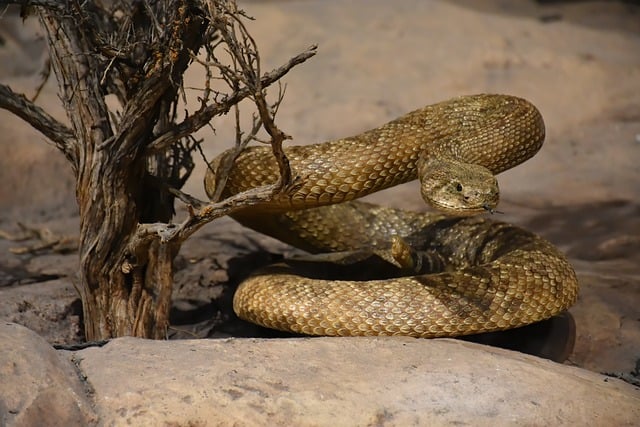
As residents and visitors explore the desert terrain of Pahrump, it’s crucial to be aware of the presence of venomous snakes in the area. Understanding the specific breeds and taking necessary precautions can help ensure personal safety. In this report, we delve into the venomous snakes found in Pahrump and provide essential tips for staying protected.
Two prominent venomous snake species reside in Pahrump:
- Mojave Rattlesnake (Crotalus scutulatus): With its distinctive diamond-shaped head and a rattle on its tail, the Mojave Rattlesnake is a venomous pit viper commonly found in the region. Their heat-sensing pits allow them to detect prey and potential threats.
- Western Diamondback Rattlesnake (Crotalus atrox): Recognizable by its triangular-shaped head and diamond patterns on its back, the Western Diamondback Rattlesnake is another venomous pit viper present in Pahrump. Their rattling tail serves as a warning when they feel threatened.
Safety measures to consider when encountering venomous snakes:
- Awareness and Prevention:
- Educate yourself and others about the appearance and behavior of venomous snakes in Pahrump.
- Wear closed-toe footwear and be cautious when venturing into areas with dense vegetation.
- Steer clear of tall grass, rock piles, and potential snake hiding spots.
- Exercise caution while reaching into or crossing areas with limited visibility.
- Respect their Habitat:
- Avoid handling, agitating, or disturbing venomous snakes.
- Maintain a safe distance and observe them from afar.
- Stay alert, as snakes are more active in warmer months and tend to seek shelter during cooler periods.
- Backyard Safety:
- Remove debris, woodpiles, and other potential snake hiding spots from your property.
- Regularly trim vegetation and bushes, keeping them away from your house.
- Seal any openings or gaps that snakes could use to access your yard or home.
- Dealing with Snake Encounters:
- Remain calm and slowly retreat if you encounter a venomous snake.
- Do not attempt to capture or kill the snake; instead, contact local authorities or professional snake removal services.
- First Aid and Medical Assistance:
- In the unfortunate event of a snakebite, seek immediate medical attention.
- Keep the bitten area as still as possible, ideally below the heart level.
- Refrain from using tourniquets, applying ice, or attempting to suck out the venom.
- Provide emergency responders with accurate information about the snake, if possible.
By staying informed, practicing caution, and implementing preventive measures, residents and visitors can coexist safely with the diverse wildlife in Pahrump’s captivating desert landscape. Remember to respect the natural habitat of these venomous snakes and prioritize personal safety at all times.






